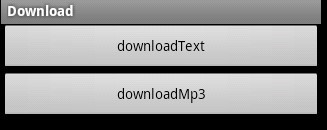在手机上下载一些文件是很常见的,比如下载一本书,下载一首Mp3等等,下面就来通过一个实例来简单介绍一下文件的下载。
文件下载实现的基本步骤:创建一个HttpURLConnection对象,获得一个InputStream对象,设置网络访问权限。
在这个实例中实现歌词和歌曲MP3的下载。
首先我们先看一下布局文件,很简单,只有两个Button控件:
<?xml version="1.0" encoding="utf-8"?>
<LinearLayout xmlns:android="http://schemas.android.com/apk/res/android"
android:layout_width="fill_parent"
android:layout_height="fill_parent"
android:orientation="vertical" >
<Button
android:id="@+id/downloadText"
android:layout_width="fill_parent"
android:layout_height="wrap_content"
android:text="downloadText"/>
<Button
android:id="@+id/downloadMp3"
android:layout_width="fill_parent"
android:layout_height="wrap_content"
android:text="downloadMp3"/>
</LinearLayout>
下载文件需要用到两个utils工具类,一个工具类(HttpDownloader.java)是用来下载文件用的,另一个(FileUtils.java)是用来将下载的文件写入到SD卡中:
HttpDownloader.java
package cn.android.sword.utils;
import java.io.BufferedReader;
import java.io.File;
import java.io.IOException;
import java.io.InputStream;
import java.io.InputStreamReader;
import java.net.HttpURLConnection;
import java.net.MalformedURLException;
import java.net.URL;
import android.util.Log;
public class HttpDownloader {
private final static String SWORD="SWORD";
public String download(String urlStr){
URL url = null;
StringBuffer sb = new StringBuffer();
String line = null;
BufferedReader buffer = null;
try {
//创建一个URL对象
url = new URL(urlStr);
//创建一个Http连接
HttpURLConnection urlConn = (HttpURLConnection) url.openConnection();
//使用IO流读取数据
buffer = new BufferedReader(new InputStreamReader(urlConn.getInputStream()));
while((line=buffer.readLine())!=null){
sb.append(line);
}
}catch (Exception e) {
e.printStackTrace();
}finally{
try {
buffer.close();
} catch (IOException e) {
e.printStackTrace();
}
}
return sb.toString();
}
//返回-1下载文件失败,返回0下载成功,返回1则是文件已存在
public int downFile(String urlStr,String path,String fileName){
InputStream inputStream = null;
FileUtils fileUtils = new FileUtils();
if(fileUtils.isFileExist(fileName)){
return 1;
}else{
try {
inputStream = getInputSteamFromUrl(urlStr);
} catch (IOException e) {
e.printStackTrace();
return -1;
}
File resultFile = fileUtils.write2SDFromInput(path, fileName, inputStream);
if(resultFile == null){
return -1;
}
}
try {
inputStream.close();
} catch (IOException e) {
e.printStackTrace();
}
return 0;
}
private InputStream getInputSteamFromUrl(String urlStr) throws MalformedURLException, IOException {
URL url = null;
url = new URL(urlStr);
HttpURLConnection urlConn = (HttpURLConnection) url.openConnection();
InputStream inputStream = urlConn.getInputStream();
return inputStream;
}
}
FileUtils.java
package cn.android.sword.utils;
import java.io.File;
import java.io.FileOutputStream;
import java.io.IOException;
import java.io.InputStream;
import java.io.OutputStream;
import android.os.Environment;
public class FileUtils {
private String SDPATH;
public String getSDPATH(){
return SDPATH;
}
public FileUtils(){
//得到当前外部存储设备的目录
// /SDCARD
SDPATH = Environment.getExternalStorageDirectory()+"/";
}
/*
* 在SD卡上创建文件
*/
public File createSDFile(String fileName) throws IOException{
File file = new File(SDPATH+fileName);
file.createNewFile();
return file;
}
/*
* 在SD卡上创建目录
*/
public File createSDDir(String dirName){
File dir = new File(SDPATH+dirName);
dir.mkdir();
return dir;
}
/*
* 判断SD卡上的文件夹是否存在
*/
public boolean isFileExist(String fileName){
File file = new File(SDPATH+fileName);
return file.exists();
}
/*
* 将一个InputStream里面的数据写入到SD卡中
*/
public File write2SDFromInput(String path,String fileName,InputStream input){
File file = null;
OutputStream output = null;
try {
//创建目录
createSDDir(path);
//创建文件
file = createSDFile(path+fileName);
//创建输出流
output = new FileOutputStream(file);
//创建缓冲区
byte buffer[] = new byte[4*1024];
//写入数据
while((input.read(buffer))!=-1){
output.write(buffer);
}
//清空缓存
output.flush();
} catch (IOException e) {
e.printStackTrace();
}finally{
try {
//关闭输出流
output.close();
} catch (IOException e) {
e.printStackTrace();
}
}
return file;
}
}
在Activity中:
DownloadActivity.java
package cn.android.sword.download;
import cn.android.sword.utils.HttpDownloader;
import android.app.Activity;
import android.os.Bundle;
import android.util.Log;
import android.view.View;
import android.view.View.OnClickListener;
import android.widget.Button;
/*
文件下载的步骤:
1:创建一个Ht't'p'URLConnection对象:HttpURLConnection urlConn = (HttpURLConnection)url.o'penConnection;
2:获得一个InputStream对象:urlConn.getInputStream();
3:设置网络访问权限:android.permissior.INTERNET;
访问SD卡步骤:
得到当前设备SD卡的目录;
Environment.getExternalStorageDirectory();
访问SD卡的权限:
android:permission.WRITE_EXTERNAL_STORAGE
*/
public class DownloadActivity extends Activity implements OnClickListener{
private final static String SWORD="SWORD";
//声明两个按钮控件
Button downloadText;
Button downloadMp3;
public void onCreate(Bundle savedInstanceState) {
super.onCreate(savedInstanceState);
setContentView(R.layout.main);
findViews();
}
//根据Id得到控件
private void findViews() {
downloadText = (Button) this.findViewById(R.id.downloadText);
downloadMp3 = (Button) this.findViewById(R.id.downloadMp3);
//添加监听事件
downloadText.setOnClickListener(this);
downloadMp3.setOnClickListener(this);
}
@Override
public void onClick(View v) {
switch(v.getId()){
case R.id.downloadText:
HttpDownloader httpDownloader = new HttpDownloader();
//所要下载文件的url路径
String lrc = httpDownloader.download("http://192.168.1.101:8080/20111021/a.lrc");
//日志打印输出
Log.i(SWORD,""+lrc);
break;
case R.id.downloadMp3:
HttpDownloader httpDownloader1 = new HttpDownloader();
int result = httpDownloader1.downFile("http://192.168.1.101:8080/20111021/m.mp3","dir/","new.mp3");
Log.i(SWORD,""+result);
break;
default:
Log.i(SWORD,"ERROR");
break;
}
}
}
本例子所下载的歌词文件和MP3文件均为我的pc上的tomcat中项目下的文件,所以需要启动我的tomcat service服务,在虚拟机上运行:

点击downloadText,查看控制台日志输出:
可以看到乱码的文件内容,然后点击downloadMp3,在SD卡的dir目录下我们能看到一个new.mp3的文件,这说明我们的文件下载成功了。
还有非常重要的一点,就是在清单中添加两个权限,一个访问SD卡的权限,还有互联网访问的权限:
<uses-permission android:name="android.permission.INTERNET"/> <uses-permission android:name="android.permission.WRITE_EXTERNAL_STORAGE"/>
